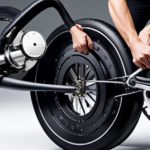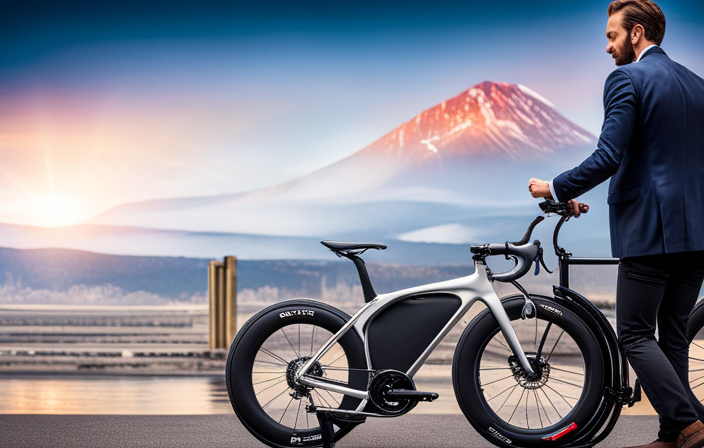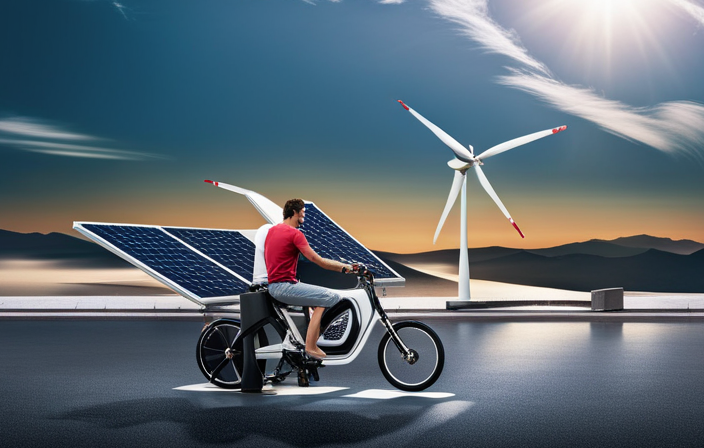Removing the battery from an electric bike may seem like a simple task, but it requires careful attention to detail. In this guide, I will walk you through the precise steps needed to safely remove the battery from your electric bike.
While it may seem ironic that such a crucial component can be easily detached, following these technical instructions will ensure a smooth and successful removal process.
Get ready to delve into the world of electric bike maintenance and learn how to master the art of battery removal.
Key Takeaways
- Removing the battery from the electric bike is the first step in the process.
- Wiping away dirt and dust with a soft, dry cloth is essential for cleaning the battery.
- Using mild detergent and water can help remove stubborn stains or grease.
- After cleaning, it is important to examine the cables for secure attachment and any signs of fraying or corrosion.
Turn off the power to the electric bike
To turn off the power to your electric bike, simply locate the power switch and flip it to the off position.
Before removing the battery, it is important to ensure its safe storage. Firstly, make sure the electric bike is turned off and the power switch is in the off position.
Next, disconnect any cables or wires connected to the battery. This will prevent any accidental electrical discharges. It is also advisable to wear protective gloves while handling the battery to avoid any potential risks. Additionally, be cautious of any sharp edges or protruding parts on the battery or bike frame.
Once these precautions have been taken, you can proceed to locate the battery compartment, which is typically located near the rear wheel or underneath the bike frame.
Locate the battery compartment
First, you’ll want to find where the power source is stored on your sleek mode of transportation. The battery compartment is usually located near the bottom of the frame, either on the downtube or the rear rack. To access it, follow these steps:
| Step | Procedure |
|---|---|
| 1 | Turn off the power to the electric bike to avoid any accidents. |
| 2 | Take necessary precautions while handling the battery, such as wearing gloves and ensuring a stable work surface. |
| 3 | Once you have located the battery compartment, remove any protective covers or panels surrounding it. This will allow you to easily access the battery for removal. |
By carefully following these steps, you can safely proceed with the battery removal process. Now, let’s move on to the next section where we will explore how to remove any protective covers or panels.
Remove any protective covers or panels
Now that you’ve located the battery compartment, it’s time to unveil the hidden treasures behind those protective covers or panels.
Before removing the battery, it’s important to take note of some common mistakes that people make. One common mistake is not properly identifying and removing all the protective covers or panels, which can lead to damage or difficulty in removing the battery. To avoid this, carefully inspect the compartment for any screws, latches, or clips that may be securing the covers or panels in place. Once you’ve identified them, use the appropriate tools to remove them, ensuring not to apply excessive force.
Additionally, here are some tips for safely removing the electric bike battery: always wear protective gloves, follow the manufacturer’s instructions, and disconnect any power source before proceeding.
With the protective covers or panels removed, you’re now ready to disconnect the battery cables and move on to the next step.
Disconnect the battery cables
Carefully untangle the cables, feeling a sense of anticipation as I prepare to free the power source that will propel my thrilling adventures. Disconnecting the battery cables is an essential step in battery maintenance to ensure the longevity of the battery lifespan.
To start, locate the positive and negative terminals on the battery. Using a wrench or pliers, loosen the nuts or screws holding the cables in place. It is important to remember to disconnect the negative cable first to prevent any accidental electrical discharge.
Once both cables are loosened, gently pull them away from the battery terminals, ensuring not to damage the cables or connectors. With the battery cables safely disconnected, I am now ready to carefully lift the battery out of the compartment, taking care not to strain my back or drop the battery.
Carefully lift the battery out of the compartment
As you gingerly raise the battery from its resting place, a surge of excitement courses through you, knowing that this pivotal moment marks the beginning of a thrilling journey ahead. Battery removal is a crucial step in electric bike maintenance, and it must be done with utmost care to avoid any damage.
Here are the key steps to carefully lift the battery out of the compartment:
- Ensure a firm grip on the battery handle.
- Lift the battery straight up, using your legs for support.
- Keep the battery level to prevent any spills or leaks.
Proper battery removal is essential for both battery maintenance and overall bike performance.
Now, let’s transition into the next section and check for any additional securing mechanisms that need to be addressed before proceeding further.
Check for any additional securing mechanisms
Take a moment to ensure that there are no other mechanisms in place that could potentially hinder your progress and dampen the excitement of embarking on this thrilling journey.
First, check for battery compatibility to avoid any mishaps. Using an incompatible battery could lead to damage or even pose a safety risk.
Once you’ve confirmed compatibility, it’s crucial to be aware of the potential risks of removing the battery. Mishandling or improper removal can result in electrical shock or damage to the bike. Carefully follow the manufacturer’s instructions and take necessary precautions.
Now that you’re aware of the risks, you can proceed with confidence to the next step: slide or release the battery from its mounting brackets, allowing for a smooth and successful removal process.
Slide or release the battery from its mounting brackets
Gently slide or release the battery from its secure mounting brackets, ensuring a smooth transition in the removal process. To remove the battery from an electric bike, it is important to follow proper procedures for battery removal and maintenance.
-
Disconnect the electrical connectors: Before removing the battery, make sure to disconnect any electrical connectors or cables attached to it. This will prevent any accidental damage to the connectors or the bike’s electrical system.
-
Support the weight of the battery: Electric bike batteries can be heavy, so it is crucial to support the weight properly during removal. Use your free hand to provide support and prevent any unnecessary strain on the connectors.
-
Place the battery in a safe and secure location: Once the battery is removed, it is essential to store it in a safe and secure location. This will prevent any accidental damage or exposure to extreme temperatures that could affect its performance.
Transitioning into the subsequent section, it is crucial to place the battery in a safe and secure location to ensure its longevity and continued functionality.
Place the battery in a safe and secure location
Ensure the longevity and continued functionality of your ride by carefully storing the battery in a secure and protected area. Proper battery storage is crucial for maintaining its performance and extending its lifespan.
When removing the battery from your electric bike, find a safe location away from extreme temperatures, moisture, and direct sunlight. Ideally, store the battery in a cool and dry area, such as a garage or a closet, and avoid placing it on a concrete floor. To prevent any potential damage, consider using a battery case or a padded bag to protect it from impacts and scratches.
Additionally, periodically check the battery for any signs of corrosion or leaks and address them promptly. By following these battery maintenance practices, you can ensure optimal performance and reliability.
Next, let’s discuss how to clean the battery compartment if necessary.
Clean the battery compartment if necessary
To keep your ride running smoothly, it’s important to give the battery compartment some attention and keep it clean. Here are some cleaning techniques and the best cleaning products you can use:
- Start by removing the battery from the electric bike.
- Use a soft, dry cloth to wipe away any dirt or dust from the battery compartment.
- For stubborn stains or grease, mix a small amount of mild detergent with water and gently scrub the affected area.
- Rinse the compartment with clean water and dry it thoroughly before reinserting the battery.
By regularly cleaning the battery compartment, you can prevent dirt build-up and potential damage to the battery.
Now, it’s time to inspect the battery for any damage or wear, ensuring its optimal performance for your next ride.
Inspect the battery for any damage or wear
Once you’ve finished cleaning the battery compartment, take a moment to inspect the battery for any signs of damage or wear.
Start by carefully examining the battery cables to ensure they are securely attached and free from any fraying or corrosion. Pay close attention to the connectors and terminals, making sure they are clean and undamaged.
Next, check the battery voltage using a multimeter or a specialized battery tester. This will help you determine if the battery is still holding a charge and functioning properly.
Look for any bulges, leaks, or cracks on the battery casing, as these can indicate internal damage. If you notice any issues during your inspection, it may be necessary to replace the battery before proceeding.
Now, let’s move on to the next step and discuss how to store the battery in a cool and dry place if needed.
Store the battery in a cool and dry place if needed
After inspecting the battery for any signs of damage or wear, it is essential to store the battery in a cool and dry place if needed. Proper storage is crucial for maintaining the battery’s capacity and ensuring its longevity. When not in use, extreme temperatures and humidity can adversely affect the battery’s performance and overall lifespan.
Therefore, finding a suitable location that is away from direct sunlight, excessive heat, and moisture is highly recommended. Additionally, it is important to keep the battery away from flammable materials and ensure it is stored in an upright position.
By following these guidelines for battery maintenance and care, you can prolong the battery’s life and optimize its performance.
Now, let’s move on to the next section and learn how to reconnect the battery cables when ready to reinstall.
Reconnect the battery cables when ready to reinstall
When you’re ready to reinstall your electric bike, make sure to reconnect the battery cables securely for a seamless and efficient ride. Reconnecting the battery cables is a crucial step in the battery installation process and requires attention to detail. To ensure a proper connection, refer to the manufacturer’s instructions for your specific electric bike model. Typically, there will be two cables to reconnect: a positive cable and a negative cable. Use a wrench or pliers to tighten the cable connections, ensuring they are snug but not over-tightened. It’s important to take battery installation precautions, such as wearing gloves and avoiding contact between the battery terminals and any metal surfaces. Once you have successfully reconnected the battery cables, you can proceed to slide or secure the battery back into its compartment, ensuring it is properly aligned and securely fastened. This will complete the installation process and prepare your electric bike for the next ride.
Slide or secure the battery back into its compartment
To successfully reinstall your electric bike, simply slide or secure the battery back into its compartment, ensuring a smooth and hassle-free ride. Did you know that proper battery alignment can increase your bike’s overall efficiency by up to 10%?
When securing the battery, follow these battery removal precautions to ensure a secure fit:
-
Align the battery connectors with the corresponding terminals in the compartment. This ensures a proper electrical connection and prevents any power loss during operation.
-
Gently slide the battery into the compartment, making sure it is snugly fit. Avoid any excessive force that could damage the connectors or the battery itself.
-
If your bike has securing straps or brackets, use them to firmly hold the battery in place. This prevents any unnecessary movement or vibrations during your ride.
-
Double-check that the battery is securely in place before proceeding to the next step.
Now, you can confidently move on to replace any protective covers or panels, ensuring the battery is well-protected and ready for your next adventure.
Replace any protective covers or panels
After sliding or securing the battery back into its compartment, the next step in the process of removing the battery from an electric bike is to replace any protective covers or panels that were removed during the battery removal process. This is an important step to ensure the battery remains protected from dust, debris, and moisture. It is crucial to carefully align the covers or panels and secure them in place according to the manufacturer’s instructions.
Battery maintenance is essential to ensure optimal performance and longevity. Regularly inspecting the battery for any signs of damage or wear is recommended. If any issues are detected, it may be necessary to replace the battery. Battery replacement should be done with caution, following the manufacturer’s guidelines and using compatible replacement batteries.
Now that the battery is securely back in place and all protective covers or panels have been replaced, it’s time to turn on the power to the electric bike and test the battery connection.
Turn on the power to the electric bike and test the battery connection
Once the power is switched on, I feel the surge of energy as the electric bike comes to life, confirming a successful battery connection. To ensure the battery connection is secure and functioning properly, I perform the following tests:
-
Test battery voltage: Using a multimeter, I measure the voltage of the battery to ensure it is within the recommended range. This helps me determine if the battery is fully charged or if it needs to be recharged.
-
Check battery connection: I inspect the battery terminals and connectors to ensure they are clean and free from any corrosion or damage. I also verify that the connectors are securely fastened to the battery terminals.
-
Test battery output: I activate the electric bike’s throttle and observe if the motor responds promptly and smoothly. Any hesitation or lack of power could indicate a weak battery connection.
-
Monitor battery performance: During a short test ride, I pay attention to the overall performance of the electric bike, including its speed, acceleration, and range. This allows me to assess if the battery connection is stable and if any further adjustments are needed.
By following these steps, I can confidently test the battery voltage and check the battery connection, ensuring a reliable and efficient electric bike experience.
Frequently Asked Questions
How do I turn off the power to my electric bike before removing the battery?
Before removing the battery from my electric bike, I ensure safety by turning off the power. As the old saying goes, "Better safe than sorry." This precaution prevents any accidental activation or electrical mishaps during the battery removal process.
What should I do if I can’t locate the battery compartment on my electric bike?
To troubleshoot battery issues on an electric bike, first, consult the owner’s manual for guidance on locating the battery compartment. If unable to find it, contact the manufacturer or a professional technician for further assistance.
Are there any special tools required to disconnect the battery cables?
Disconnecting the battery cables does not require any specialized tools. However, it is crucial for proper battery maintenance. By ensuring a secure and clean connection, you can maximize the performance and lifespan of your electric bike’s battery.
What should I do if I notice any damage or wear on the battery during inspection?
If I notice any damage or wear on the battery during inspection, I should not attempt to repair it myself. Instead, I should find a replacement battery from a reliable supplier to ensure the safety and performance of my electric bike.
How can I ensure that the battery is securely placed back into its compartment?
To ensure the battery is securely placed back into its compartment, follow these tips for maintaining the battery compartment in an electric bike: clean it regularly, check for any loose connections, use proper fasteners, and inspect for any signs of damage or wear. Remember, "a stitch in time saves nine."
Conclusion
In conclusion, removing the battery from an electric bike is a simple process that can be done by following a few steps. By turning off the power and locating the battery compartment, you can easily disconnect the battery cables and lift the battery out.
It is important to reconnect the cables properly and securely slide the battery back into its compartment. One interesting statistic to note is that the average weight of an electric bike battery is around 5-7 pounds, making it relatively lightweight and easy to handle during removal and installation.
















